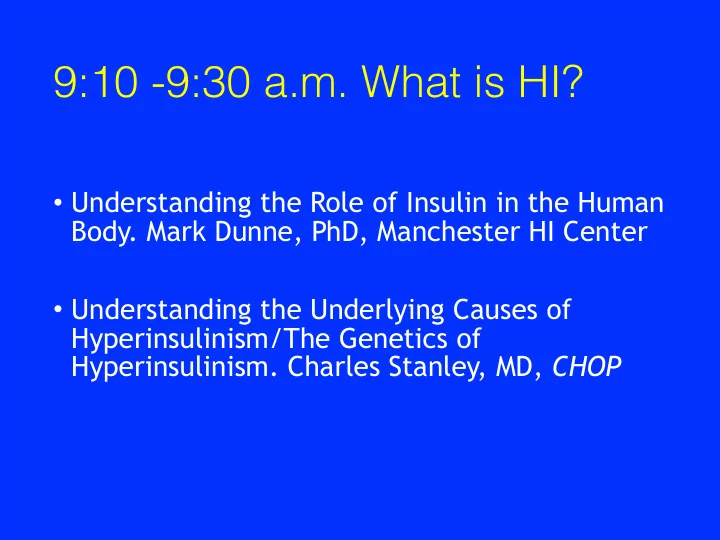

9:10 -9:30 a.m. What is HI? • Understanding the Role of Insulin in the Human Body. Mark Dunne, PhD, Manchester HI Center • Understanding the Underlying Causes of Hyperinsulinism/The Genetics of Hyperinsulinism. Charles Stanley, MD, CHOP
What is Hyperinsulinism (HI)??? ➢ HI is sometimes called: Hyperinsulinemic Hypoglycemia (low blood sugar caused by excessive insulin) • hyper = too much …….. insulinemic = blood insulin level • hypo = too low………..glycemia = blood glucose level ➢ Big worry is that a low blood glucose can cause brain injury, since glucose is the essential fuel for the brain ➢ In HI, the problem is not over-production of insulin, but a failure to turn off insulin adequately during fasting when blood glucose is low ➢ In certain types of HI, specific foods (commonly, protein) can provoke hypoglycemia ➢ HI in adults is usually caused by an acquired insulin tumor (insulinoma) ➢ HI in children is usually caused by a genetic disorder of insulin secretion
HI is Genetic: Recessive or Dominant Inheritance ABCC8 delPhe1388 homozygous 1 2 3 4 5 6 7 8 9 10 11 12 ABCC8 p.delSer1387 heterozygous
glucose glucose leucine amino acids dominant dominant recessive gain of function gain of function loss of function dominant glucokinase glutamate gain of function HK1 SCHAD + GDH G6P pyruvate MCT1 dominant loss of function dominant Insulin gain of function ATP ATP HNF4a ATP UCP2 HNF1a dominant loss of function + dominant loss of function - Ca ++ diazoxide Ca ++ K + - + Ψ somatostatin calcium channel K ATP channel recessive or dominant glyburide loss of function N.B. Actually, 19 HI genes are known
HISTOLOGIC FORMS OF KATP-HI HYPERINSULINISM Diffuse form Focal form
Focal HI ➢ ~50% of severe congenital HI cases ➢ Clinically identical to diffuse KATP-HI ➢ Diazoxide unresponsive ➢ Potential for cure by surgical resection ➢ 2-Hit Genetic Mechanism: 1. Clonal loss of maternal chromosome 11p region plus 2. Duplication of a paternal KATP-channel mutation
Focal Congenital HI -- Two Hits: (Maternal LOH & Paternal K ATP Defect) pat pat mat pat IGF2 INS BWS IGF2 IGF2 p57 KIP2 p57 KIP2 H19 SUR1 SUR1 SUR1 H19 Kir6.2 ( KCNJ11 ) SUR1 ( ABCC8 ) pancreas Chromosome 11
Rapid Genetic Testing for HI Univ of Pennsylvania Genetic Diagnostic Lab Level 1 Congenital Hyperinsulinism 5-7 days Panel: ABCC8, KCNJ11, GLUD1, GCK Level 2 Congenital Hyperinsulinism Panel: ABCC8, KCNJ11, GLUD1, GCK, 4-6 weeks SLC16A1, UCP2, HNF1A, HNF4A, HADH
Predicting Focal-HI by Genetic Testing of Patient and Parents Focal-HI Diffuse-HI Single recessive KATP mutation 144 9 No single recessive KATP mutation 4 95 A single heterozygous recessive mutation accurately predicts focal-HI: Sensitivity: 97% Specificity: 91% When paternal inheritance is confirmed: Sensitivity: 97% Specificity: 93%
F-DOPA PET images--Focal HI
Clinical Features of Congenital Hyperinsulinism gene genetics Sensitivity to stimuli / inhibitors diazoxide protein leucine calcium exercise KATP (ABCC8 = SUR1) rec - + - + - (KCNJ11 = Kir6.2) dom +/- + - + - KATP (ABCC8 = SUR1) (KCNJ11 = Kir6.2) GDH (HI-HA) dom + + + - - GCK dom - - - - - rec + + + - - SCHAD MCT1 dom ? - - - + HNF4a & HNF1a dom + +? +? +? - dom + - - - - UCP2 dom + - - - - HK1 KEY: Most common Less Common Rare
Mutations in 882 Children with Congenital HI (1997-2018) (?dom mosaic KATP/GCK) (1 dom GCK) zero mutations diffuse 2 rec SCHAD 1 dom UCP2 1 dom HNF4A 1 dom HNF1A diffuse (1 dom KATP) zero mutations 1 dom GLUD1 (?dom mosaic KATP/GLUD1) focal (1 rec KATP) 1 dom KATP diffuse (2 rec KATP) focal (1 rec KATP) (mostly KATP mutations) (mostly no mutations) (no surgery) Diazoxide-Responsive Diazoxide-Unresponsive (355) (527)
Why are there “Missing Mutations”? • In some HI patients, standard genetic testing cannot find any disease-causing mutation. • Especially true for diazoxide-responsive patients (over 50%) • Possible reasons: Novel Gene: i.e., a new HI gene that hasn’t been discovered yet 1. 2. De Novo Embryonic Mutation: i.e., an embryonic dominant HI gene mutation in pancreatic islets, not inherited from a parent and not present in patient’s blood cells (also called a “somatic“ mutation) 3. Syndromic HI: e.g., a genetic disorder affecting tissues in addition to islets that are not included in HI gene testing (Beckwith Syndome, Turner Syndrome, Kabuki Syndrome, etc.)
Surgical Outcomes of CHOP Focal vs Diffuse HI (since 2008 with Genetic Testing & F-DOPA PET)
HI and Genes (summary) • 9 different genes are associated with HI • Genetic testing is important for predicting: – best type of management (diazoxide responsiveness, potential for surgically-curable focal lesion) – risk of recurrence (family members & future offspring) • Genetic test results need to be available within less than one week and should include simultaneous testing of parents
ChangHong Li Thank You Pan Chen Kara Boodhansingh Arupa Ganguly Diva DeLeon Mark Yudkoff Itzak Nissim CHOP Hyperinsulinism Center Michael Bennett Franz Matschinsky http://hyperinsulinism.chop.edu Tom Smith hyperinsulinism@email.chop.edu 215-590-7682
Recommend
More recommend